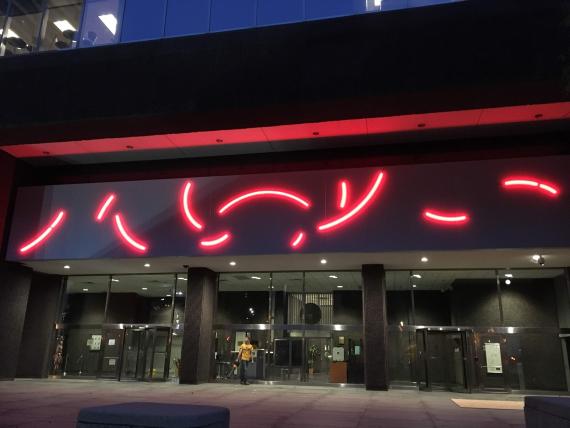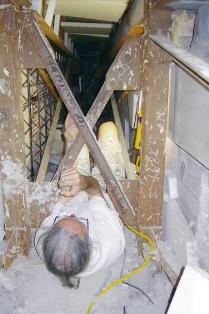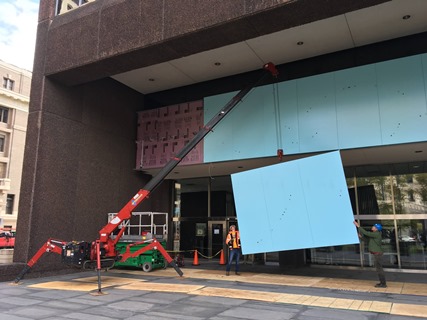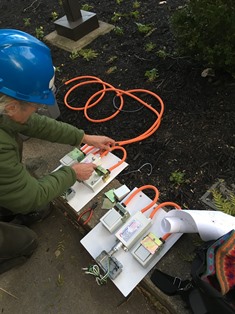Neon artwork illuminates Dayton again after 10 year hiatus
40-year-old Red Neon Circle Fragments on a Blue Wall given complete overhaul

On the eve of Halloween, the artwork Red Neon Circle Fragments on a Blue Wall 1978 once again illuminated the exterior of the Dayton, Ohio, Federal Building for the first time in 10 years.
Since 2008 the piece had undergone extensive repairs to not only restore the beauty of its colored bulbs and paneling but also the safety and code compliance of its electrical wiring and the framework holding it in place.
Created by world-renowned neon artist Stephen Antonakos (1926 – 2013), a Greek born American sculptor, Red Neon Circle Fragments was intended to “lift the mood of the entrance, and make it more inviting.” The piece spans the entire front entrance of the building with a band of bright red neon tube fragments that appear to float on a sky-blue backdrop. Depending on the time of day, the blue band and glowing curved shapes either recede or become dominant, an effect the artist intended, with the glowing red neon evoking the sun and blue panels the sky while illuminating the dark overhang of the Brutalist-style building day and night.
Though its neon was controversial when the work was originally installed 40 years ago, the City of Dayton heralded it as “the first public artwork of major importance” and a “vital part of Dayton’s cityscape.”

But after 40-years of weathering, the work’s neon tubes and connections were discolored, misshapen and bent, and the blue metal panels had corroded and faded, leaving the “face” of the building an eyesore. In addition, holes in the precast concrete envelope of the building behind the art panels allowed outside air to flow into tenant space, leading to constant complaints of temperature fluctuations.
Regular repairs and maintenance were not performed over the years as transformer boxes and wiring to the power supply were only accessible through a small tenant-office-space panel, barely big enough for one person to enter (photo right).
The conditions prompted GSA’s Fine Arts Program to send conservators to the site in 2008 to perform the first comprehensive inspection since its installation in 1978. Inspections revealed that the work was out of code and a safety hazard, so power was shut off immediately.

GSA’s Fine Arts Program worked with neon sign fabricators, architects, engineers and electricians to complete the multi-phased, $164,000 conservation project during the next 10 years, returning the artwork to the original condition the artist had intended.
First, compact specialty cranes removed the panels. Next, to mitigate the penetration of outside air and escape of conditioned air through the electrical wiring holes in the exterior wall, GSA completed a BA54 repair and alteration project to provide insulation and repairs to the area while the work was being restored at the conservators’ off-site location. The BA54 project also added code-compliant wiring, structural repairs behind the artwork and a more accessible maintenance space.

Next in 2013, GSA and the conservator reviewed original drawings and interviewed the artist’s estate to fully understand the artist’s intent for the work. Subcontractors City Neon Lights (Cincinnati, Ohio) designed the supporting electrical system and painstakingly reproduced the large, delicate neon tubes to the artist’s original specifications, with each custom-made glass bulb bent freehand over a torch to match the exact shape of the artist’s specifications and fit the openings in the blue panels.
Finally, a full scale mock-up of the work was put together at the conservation lab to ensure everything lined up and operated correctly, and the entire piece was disassembled and shipped to the building, where conservators and electricians used cranes and lifts to hoist the panels and bulbs into place, reassemble the artwork onto a new structural support system, and attach the wiring and transformers to a fully-accessible exterior location.

 U.S. General Services Administration
U.S. General Services Administration